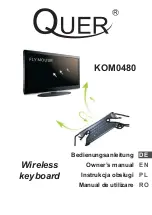
10-144
KDFX Reference
KDFX Algorithm Specifications
speci
fi
ed frequency. Negative values cut the signal at the speci
fi
ed
frequency.
CmpSCMidF, Mid Freq
The center frequency of the parametric mid
fi
lter in intervals of one
semitone. The boost or cut will be at a maximum at this frequency.
CmpSCMidW, Mid Width
The bandwidth of the side chain parametric mid
fi
lter may be adjusted.
You specify the bandwidth in octaves. Small values result in a very
narrow
fi
lter response. Large values result in a very broad response.
Reverb W/D
A simple mix of the reverb sound with the dry (compressed) sound.
Rv PreDlyL/R
The delay between the start of a sound and the output of the
fi
rst reverb
re
fl
ections from that sound. Longer predelays can help make larger
spaces sound more realistic. Longer times can also help improve the
clarity of a mix by separating the reverb signal from the dry signal, so the
dry signal is not obscured. Likewise, the wet signal will be more audible
if delayed, and thus you can get by with a dryer mix while maintaining
the same subjective wet/dry level.
Rv Time
The reverb time displayed is accurate for normal settings of the other
parameters (HF Damping =
25088 kHz
, and Rv DiffScl, Rv SizeScl and
Rv Density =
1.00x
). Changing Rv Time to
Inf
creates an in
fi
nitely
sustaining reverb.
Rv Type
Changes the con
fi
guration of the reverb algorithm to simulate a wide
array of carefully designed room types and sizes. This parameter
effectively allows you to have several different reverb algorithms only a
parameter change away. Smaller Rv Types will sound best with shorter
Rv Times, and vice versa. (Note that since this parameter changes the
structure of the reverb algorithm, you may not modulate it.)
Rv HF Damp
Reduces high frequency components of the reverb above the displayed
cutoff frequency. Removing higher reverb frequencies can often make
rooms sound more natural.
Rv DiffScl
A multiplier which affects the diffusion of the reverb. At
1.00x
, the
diffusion will be the normal, carefully adjusted amount for the current
Rv Type. Altering this parameter will change the diffusion from the
preset amount.
Rv SizeScl
A multiplier which changes the reverb size of the current room. At
1.00x
,
the room will be the normal, carefully tweaked size of the current
Rv Type. Altering this parameter will change the size of the room, and
thus will cause a subtle coloration of the reverb (since the room’s
dimensions are changing).
Rv Density
A multiplier which affects the density of the reverb. At
1.00x
, the room
density will be the normal, carefully set amount for the current Rv Type.
Altering this parameter will change the density of the reverb, which may
color the room slightly.
Summary of Contents for K2661
Page 18: ...2 4 LFOs LFO Shapes...
Page 34: ...3 16 DSP Algorithms...
Page 54: ...5 4 MIDI Note Numbers Note Numbers for Percussion Keymaps...
Page 72: ...7 10 System Exclusive Protocol K2661 System Exclusive Implementation...
Page 82: ...9 4 Upgrading Sample Memory Choosing and Installing a SIMM for K2661 Sample Memory...
Page 334: ...10 252 KDFX Reference KDFX Algorithm Specifications...
Page 340: ...11 6 Glossary...
Page 382: ...12 42 Triple Modular Processing Alphanumeric Buttonpad Entries for DSP Functions...
Page 392: ...B 6 SysEx Control of KDFX MSB and LSB...
Page 442: ...D 20 Contemporary ROM Block Objects Controller Assignments Contemporary ROM Block...
Page 490: ...H 12 General MIDI Standard Mode Controller Assignments...
Page 492: ...I 2 Live Mode Objects Live Mode Programs...
Page 498: ...K2661 Musician s Reference Index...
Page 500: ......
















































